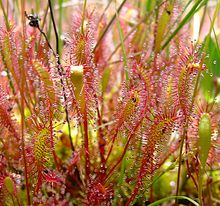| Drosera anglica | |
|---|---|

| |
| Scientific classification | |
| Kingdom: | Plantae |
| Clade: | Tracheophytes |
| Clade: | Angiosperms |
| Clade: | Eudicots |
| Order: | Caryophyllales |
| Family: | Droseraceae |
| Genus: | Drosera |
| Subgenus: | Drosera subg. Drosera |
| Section: | Drosera sect. Drosera |
| Species: | D. anglica
|
| Binomial name | |
| Drosera anglica | |
| Synonyms[2] | |
|
List
| |
Drosera anglica, commonly known as the English sundew[3] or great sundew,[4] is a carnivorous flowering plant species belonging to the sundew family Droseraceae. It is a temperate species with a circumboreal range,[2] although it does occur as far south as Japan, southern Europe, and the island of Kauai in Hawaii, where it grows as a tropical sundew. It is thought to originate from an amphidiploid hybrid of D. rotundifolia and D. linearis, meaning that a sterile hybrid between these two species doubled its chromosomes to produce fertile progeny which stabilized into the current D. anglica.[5]
- ^ NatureServe (2024). "Drosera anglica". Arlington, Virginia. Archived from the original on 9 April 2023. Retrieved 6 March 2024.
- ^ a b "Drosera anglica Huds". Plants of the World Online. Royal Botanic Gardens, Kew. Retrieved 6 March 2024.
- ^ USDA, NRCS (n.d.). "Drosera anglica". The PLANTS Database (plants.usda.gov). Greensboro, North Carolina: National Plant Data Team. Retrieved 18 January 2016.
- ^ BSBI List 2007 (xls). Botanical Society of Britain and Ireland. Archived from the original (xls) on 2015-06-26. Retrieved 2014-10-17.
- ^ Schnell, Donald (1999). "Drosera anglica Huds. vs. Drosera x anglica: What is the Difference?" (PDF). Carnivorous Plant Newsletter. 28 (4): 107–115. doi:10.55360/cpn284.ds361. S2CID 248090242.
